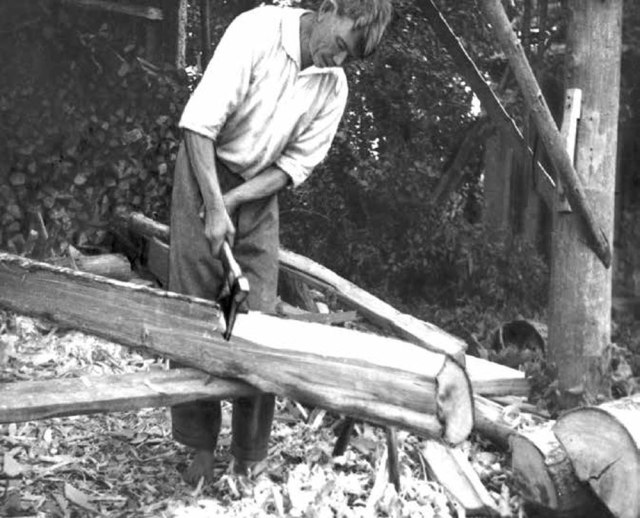
This is an excerpt from “Woodworking in Estonia” by Ants Viires; translated by Mart Aru.
MATERIAL USED. In Europe bent-board containers were made of various types of timber. The flexible and easily cut aspen was popular in Estonia, and was also widely used for that purpose in Russia, Finland and northern Sweden.35 In southern Estonia linden was also used. The sides of the sieve, sifter and “külimit” were all made of aspen. In the case of chests and hampers, birch and ash were often used (especially in the islands), as well as bird cherry. In western Saaremaa chests were mostly made of oak. Oak served as raw material for chests in southern Sweden and southwestern Finland.36 In some countries coniferous wood, pine or spruce, were used for the bent sides of the container, but this was not the case in Estonia. On the other hand, the base of many of these containers was often made of pine or spruce.
CUTTING. The boards were always brought in when still green. This was done so as to prevent them from cracking during the bending process. Furthermore, the board had to be split with an axe, not cut with a saw. The sawn board would easily crack or chip, whereas the chopped board retained the tree rings in good condition and facilitated the bending process. For chests, sieves and sifters, boards 5/16″–1/2″ (7-12 mm) thick were used: for hampers 3/4″- 1-1/2″ (2-4 cm). In western Saaremaa very thin (around 1/8″ or 2-4 mm) boards of oak were sometimes used for chests.
There were two ways of cutting boards for the bent container. The primitive method, used throughout the country, was to make use of the smooth surface of the barked tree for the surface of the container, cutting the log accordingly. This process required preliminary cutting of the log to the right size, i.e., into two or four sections. After that the inside surface was hewn out with an axe and a trough axe, until a curved board of the desired thickness was achieved. The inside surface was finally smoothed with a draw knife. Such a board is easily bent. This method was also common in Russia and Finland.37
The author had the chance to follow the second method closely in Avinurme in the summer of 1947. Apart from Avinurme, this way of cutting is used also in the Nõva and Hiiumaa home industries. Here, again, the log was first cut into half and each half was further divided into thirds or halves, depending on the original thickness.

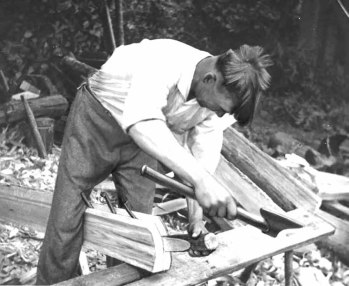
Two boards were obtained from each of the sections. The sharp edges of the segment were smoothed with an axe (Fig. 127), and a line was marked along which the cutting was to be done. The splitting itself followed with three wedges first driven into the edge: one in the middle, and one at each end. Sometimes only one large wedge was used, placed in the middle. As the split formed, smaller wedges were driven into the wood to “guide the split” (Fig. 128). And thus, by driving the wedges even deeper, a double size board was obtained. It was then further split in two, using the same method (Fig. 129). The process is actually very fast, lasting no more than five to 10 minutes.
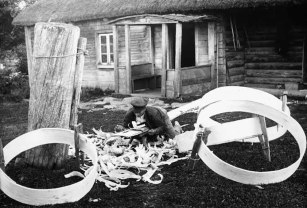
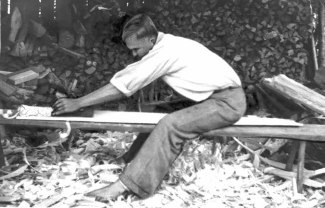
Both sides of the board are then scraped with the axe, the work being done on the bench. At the same time the bark is removed and the stroke of the axe has to fall along the rings of the wood. Then the curved surface on the outside is cut straight with a planing knife (Fig. 130) and the inside planed with a curved jack plane (Fig. 131). In Avinurme the latter job was done with a draw knife as late as the first decade of the 20th century (Fig. 132).
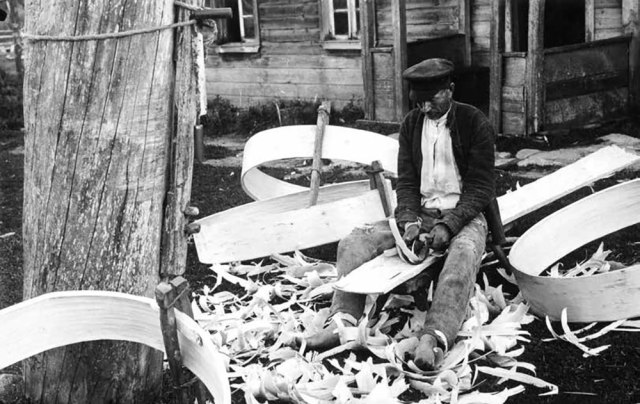
Splitting with axe and wedges was typical in Sweden and central Europe and was also known in areas where home industry was prevalent (especially for smaller boards). Here they were cut straight, and not along the tree rings, as was the use in Estonia.38 The latter is more closely associated with the first, more primitive method.
35 Филиппов, p. 222; Granlund, p.115-116.
36 Granlund, loc. cit.
37 Филиппов, pp. 224-225 (Simbirsk Gubernia); Tруды XI, p.3158 (Vyatka Gubernia), Granlund, pp. 121-122. Karrakoski, p.144.
38 Granlund, pp. 118-120; Филиппов , p. 224.
— MB